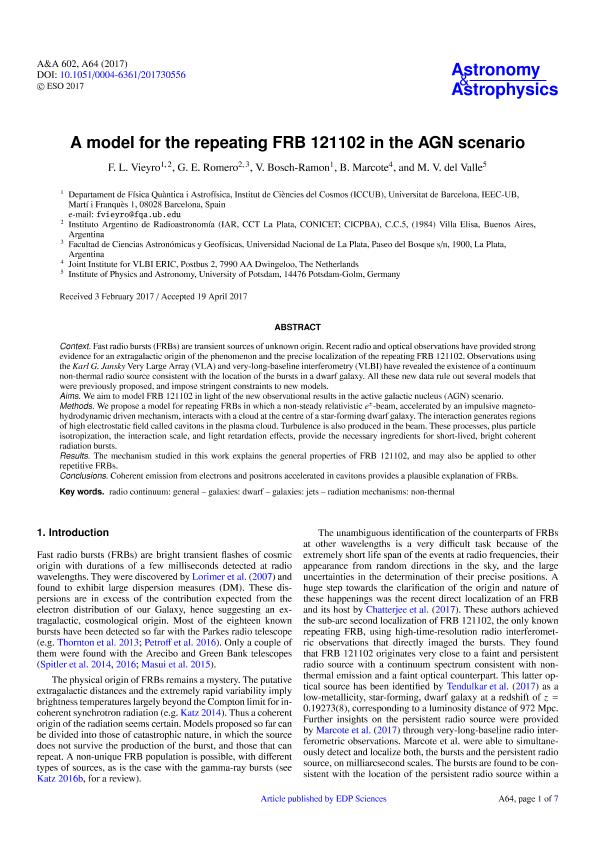Artículo
A model for the repeating FRB 121102 in the AGN scenario
Vieyro, Florencia Laura ; Romero, Gustavo Esteban
; Romero, Gustavo Esteban ; Bosch Ramon, Valentí; Marcote, B.; del Valle, Maria Victoria
; Bosch Ramon, Valentí; Marcote, B.; del Valle, Maria Victoria
 ; Romero, Gustavo Esteban
; Romero, Gustavo Esteban ; Bosch Ramon, Valentí; Marcote, B.; del Valle, Maria Victoria
; Bosch Ramon, Valentí; Marcote, B.; del Valle, Maria Victoria
Fecha de publicación:
06/2017
Editorial:
EDP Sciences
Revista:
Astronomy and Astrophysics
ISSN:
0004-6361
Idioma:
Inglés
Tipo de recurso:
Artículo publicado
Clasificación temática:
Resumen
Context. Fast radio bursts (FRBs) are transient sources of unknown origin. Recent radio and optical observations have provided strong evidence for an extragalactic origin of the phenomenon and the precise localization of the repeating FRB 121102. Observations using the Karl G. Jansky Very Large Array (VLA) and very-long-baseline interferometry (VLBI) have revealed the existence of a continuum non-thermal radio source consistent with the location of the bursts in a dwarf galaxy. All these new data rule out several models that were previously proposed, and impose stringent constraints to new models. Aims. We aim to model FRB 121102 in light of the new observational results in the active galactic nucleus (AGN) scenario. Methods. We propose a model for repeating FRBs in which a non-steady relativistic e±-beam, accelerated by an impulsive magnetohydrodynamic driven mechanism, interacts with a cloud at the centre of a star-forming dwarf galaxy. The interaction generates regions of high electrostatic field called cavitons in the plasma cloud. Turbulence is also produced in the beam. These processes, plus particle isotropization, the interaction scale, and light retardation effects, provide the necessary ingredients for short-lived, bright coherent radiation bursts. Results. The mechanism studied in this work explains the general properties of FRB 121102, and may also be applied to other repetitive FRBs. Conclusions. Coherent emission from electrons and positrons accelerated in cavitons provides a plausible explanation of FRBs.
Archivos asociados
Licencia
Identificadores
Colecciones
Articulos(IAR)
Articulos de INST.ARG.DE RADIOASTRONOMIA (I)
Articulos de INST.ARG.DE RADIOASTRONOMIA (I)
Citación
del Valle, Maria Victoria; Marcote, B.; Bosch Ramon, Valentí; Romero, Gustavo Esteban; Vieyro, Florencia Laura; A model for the repeating FRB 121102 in the AGN scenario; EDP Sciences; Astronomy and Astrophysics; 602; 6-2017
Compartir
Altmétricas



